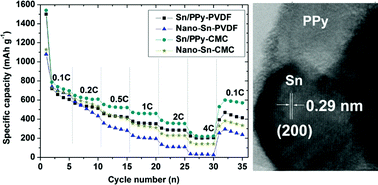
This HOT article reports an interesting study on Sn/PPy composite as negative electrode using carboxymethyl cellulose (CMC) binder for Li-ion batteries. The electrochemical results show that both the capacity retention and the rate capability are in the same order of nano-Sn/PPy-CMC > nano-Sn/PPy-PVDF > nano-Sn-CMC > nano-Sn-PVDF. Scanning electronic microscopy (SEM) and electrochemical impedance spectroscopy (EIS) results show that CMC can prevent the formation of cracks in electrodes caused by the big volume changes during the charge–discharge process, and the PPy in the composite can provide a conducting matrix and alleviate the agglomeration of Sn nanoparticles. The present results indicate that the nano-Sn/PPy composite could be suitable for the next generation of anode materials.
Read more for FREE about these interesting developments in new generation anode materials at:
Tin/polypyrrole composite anode using sodium carboxymethyl cellulose binder for lithium-ion batteries
Shu-Lei Chou, Xuan-Wen Gao, Jia-Zhao Wang, David Wexler, Zhao-Xiang Wang, Li-Quan Chen and Hua-Kun Liu
Dalton Trans., 2011, Advance Article
DOI: 10.1039/C1DT10396B










